VOYAGE TO THE MOTHERLAND: A LOOK AT INDIAN CULTURE AND HISTORY
 By Param BhatterStaff WriterEvery few years, my family and I travel back to India to visit all of my cousins and relatives who live there. This winter break, I decided that I should spend more time learning about my cultural heritage, which stems from my North Indian roots. I decided to visit two separate cities, New Delhi and Jaipur. The former is where I was born and the latter is where my family originates from.This photo journal displays some of the rich history, religion and culture that can be found in India today. From the palaces of Maharajas and Maharanis (kings and queens), to the Hindu and Muslim relics throughout the city, and the crowded streets with cultural crafts and food, India has much to display.New DelhiThe largest city in the north of the country, New Delhi is also the capital of India. Due to its proximity to a Pakistan, there is rich Muslim culture found throughout the city and its relics, even though many citizens are still Hindu.
By Param BhatterStaff WriterEvery few years, my family and I travel back to India to visit all of my cousins and relatives who live there. This winter break, I decided that I should spend more time learning about my cultural heritage, which stems from my North Indian roots. I decided to visit two separate cities, New Delhi and Jaipur. The former is where I was born and the latter is where my family originates from.This photo journal displays some of the rich history, religion and culture that can be found in India today. From the palaces of Maharajas and Maharanis (kings and queens), to the Hindu and Muslim relics throughout the city, and the crowded streets with cultural crafts and food, India has much to display.New DelhiThe largest city in the north of the country, New Delhi is also the capital of India. Due to its proximity to a Pakistan, there is rich Muslim culture found throughout the city and its relics, even though many citizens are still Hindu. The Lotus temple, which was constructed in 1986, is probably one of the most recent landmarks to be built in the city of New Delhi. It is actually a Baha’i temple, and one of the largest of its kind. As indicated by its name, the temple is designed in the shape of a lotus flower, which represents divinity and spirituality in Indian culture.
The Lotus temple, which was constructed in 1986, is probably one of the most recent landmarks to be built in the city of New Delhi. It is actually a Baha’i temple, and one of the largest of its kind. As indicated by its name, the temple is designed in the shape of a lotus flower, which represents divinity and spirituality in Indian culture.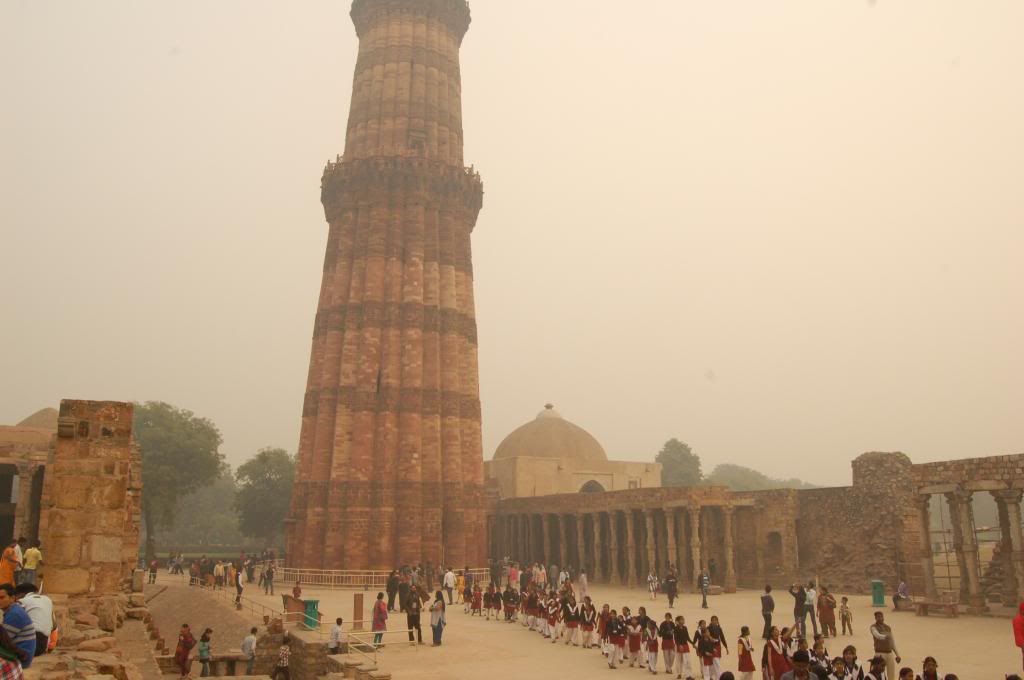 Qutb Minar is one of the oldest standing towers in India, measuring about 73 meters in height. Built from red sandstone and marble in the year 1192, this tower is actually an Islamic monument covered with Arabic inscriptions. This tower is the main attraction of the Qutb complex, which over 500 years ago was a religious sight where many people of the Islamic faith would gather and pray. Most of this site has been damaged over time from pollution, and the tower is the only building in the complex that has ever been restored.
Qutb Minar is one of the oldest standing towers in India, measuring about 73 meters in height. Built from red sandstone and marble in the year 1192, this tower is actually an Islamic monument covered with Arabic inscriptions. This tower is the main attraction of the Qutb complex, which over 500 years ago was a religious sight where many people of the Islamic faith would gather and pray. Most of this site has been damaged over time from pollution, and the tower is the only building in the complex that has ever been restored.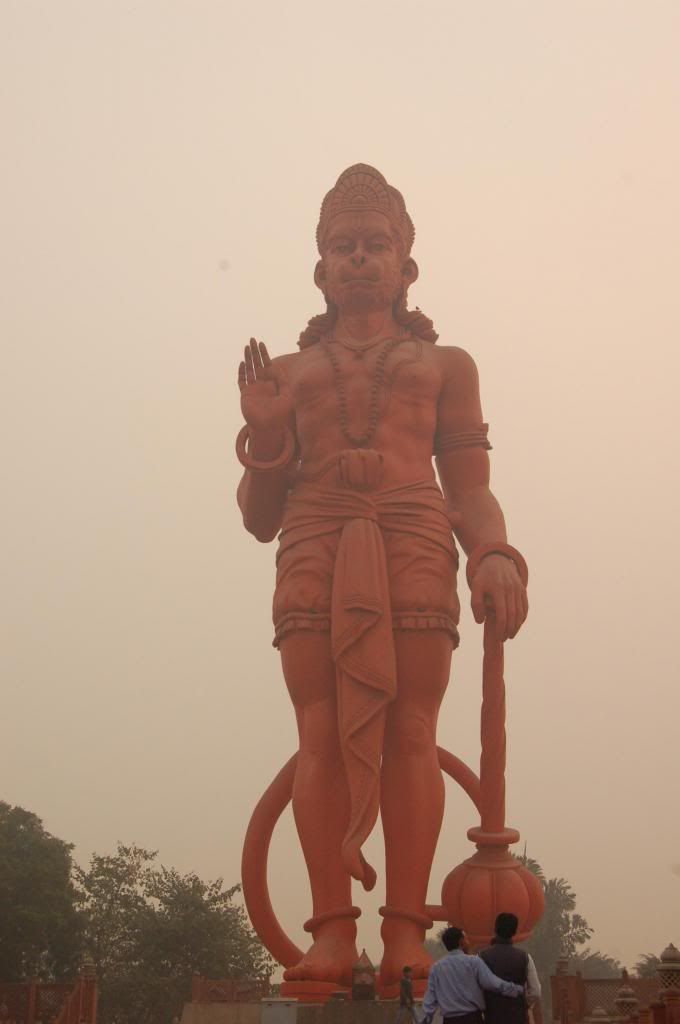 This giant statue found in Karol Bagh stands over a 100 feet tall on the outskirts of the Chatarpur Temple. The god shown here is Hanuman, who is famous in Indian folklore and from one of the most celebrated religious texts of Hindu culture. Legend has it that he once lifted an entire island on his finger to aid a dear friend in need of a lifesaving herb from that island. Hanuman is the deity that is often worshiped to protect against trouble from evil spirits.
This giant statue found in Karol Bagh stands over a 100 feet tall on the outskirts of the Chatarpur Temple. The god shown here is Hanuman, who is famous in Indian folklore and from one of the most celebrated religious texts of Hindu culture. Legend has it that he once lifted an entire island on his finger to aid a dear friend in need of a lifesaving herb from that island. Hanuman is the deity that is often worshiped to protect against trouble from evil spirits. The Red Fort, though no longer very red due to the pollution found in New Delhi, is located at the heart of the city. It was the center of residence for the Mughal emperors for a good 200 years, until it was put out of commission in the mid-17th century. It was built by one of the most famous Indian emperors of all time, Shah Jahan. Even though the Mughals were Muslim, the architecture of the Red Fort reflects Hindu and Persian cultures as well.
The Red Fort, though no longer very red due to the pollution found in New Delhi, is located at the heart of the city. It was the center of residence for the Mughal emperors for a good 200 years, until it was put out of commission in the mid-17th century. It was built by one of the most famous Indian emperors of all time, Shah Jahan. Even though the Mughals were Muslim, the architecture of the Red Fort reflects Hindu and Persian cultures as well.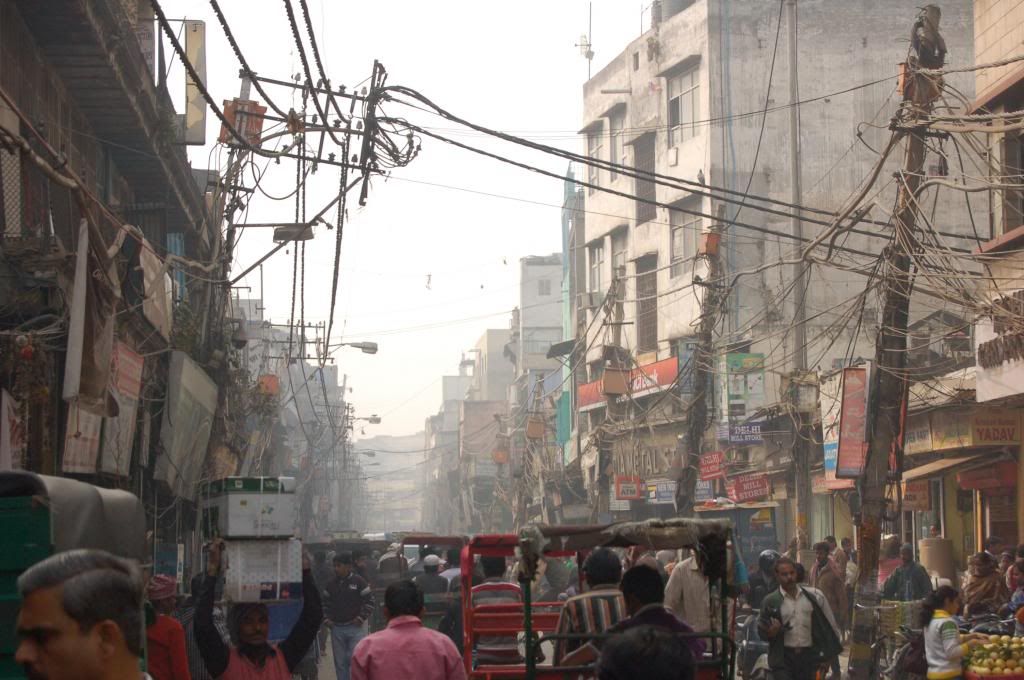 This central suburb in New Delhi is known as Chandni Chowk, one of the most famous markets in India. The streets are full of traffic from sunrise to sunset, occupied by motorcycles, cars and rickshaws. Specifically, the market focuses on textiles and electronics, with many great street food vendors all around. Unfortunately, I got the stomach flu from eating the street food here, which I probably shouldn’t have done as a foreigner. Even though the food was amazing, it was definitely not worth the trouble!JaipurJaipur is located in the state of Rajasthan, one of the most beautiful states in all of India. Although mostly desert, the state has been home to many palaces and emperors, who have created many monuments. The city of Jaipur is the capital of Rajasthan, and just happens to be the home of the type of Indian that I am, which is Marathi. My family and I spent a couple days here touring the many palaces and temples that were built in India, many of which were the oldest of their kind.
This central suburb in New Delhi is known as Chandni Chowk, one of the most famous markets in India. The streets are full of traffic from sunrise to sunset, occupied by motorcycles, cars and rickshaws. Specifically, the market focuses on textiles and electronics, with many great street food vendors all around. Unfortunately, I got the stomach flu from eating the street food here, which I probably shouldn’t have done as a foreigner. Even though the food was amazing, it was definitely not worth the trouble!JaipurJaipur is located in the state of Rajasthan, one of the most beautiful states in all of India. Although mostly desert, the state has been home to many palaces and emperors, who have created many monuments. The city of Jaipur is the capital of Rajasthan, and just happens to be the home of the type of Indian that I am, which is Marathi. My family and I spent a couple days here touring the many palaces and temples that were built in India, many of which were the oldest of their kind.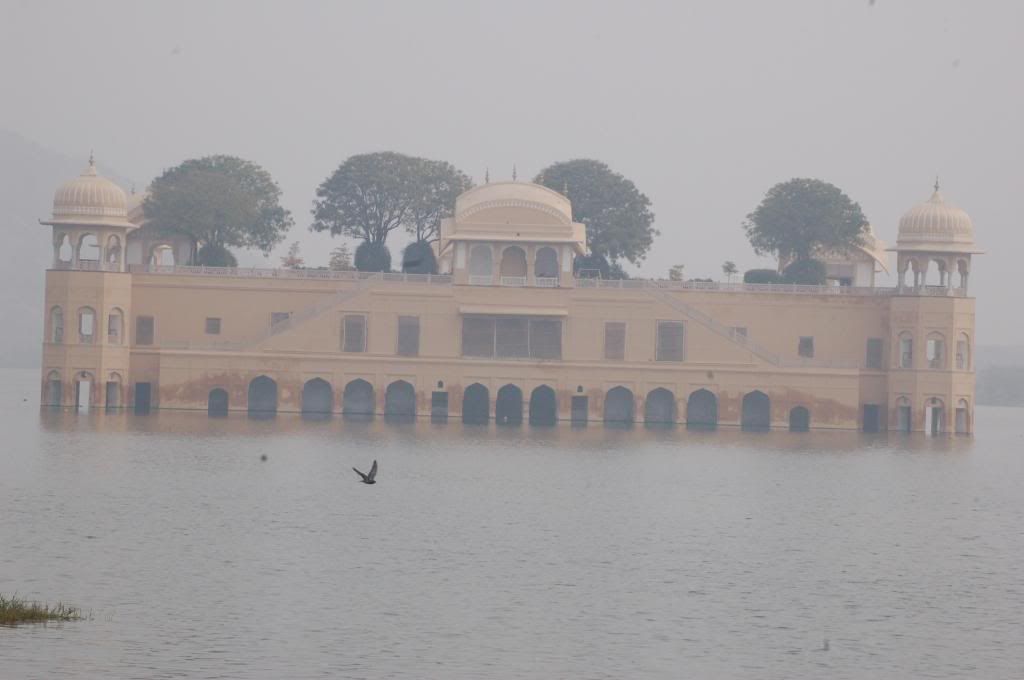 This palace, surrounded by water on all sides, is known as Jal Mahal. Closed to tourists, this is the closest you can get to actually entering the building. It is located in the Man Sagar Lake in Jaipur, and is built out of red and pink sandstone. Unfortunately, the pollution in the air limits the view of the surroundings, but without the pollution you would be able to see that the temple overlooks one of the largest dams in India.
This palace, surrounded by water on all sides, is known as Jal Mahal. Closed to tourists, this is the closest you can get to actually entering the building. It is located in the Man Sagar Lake in Jaipur, and is built out of red and pink sandstone. Unfortunately, the pollution in the air limits the view of the surroundings, but without the pollution you would be able to see that the temple overlooks one of the largest dams in India.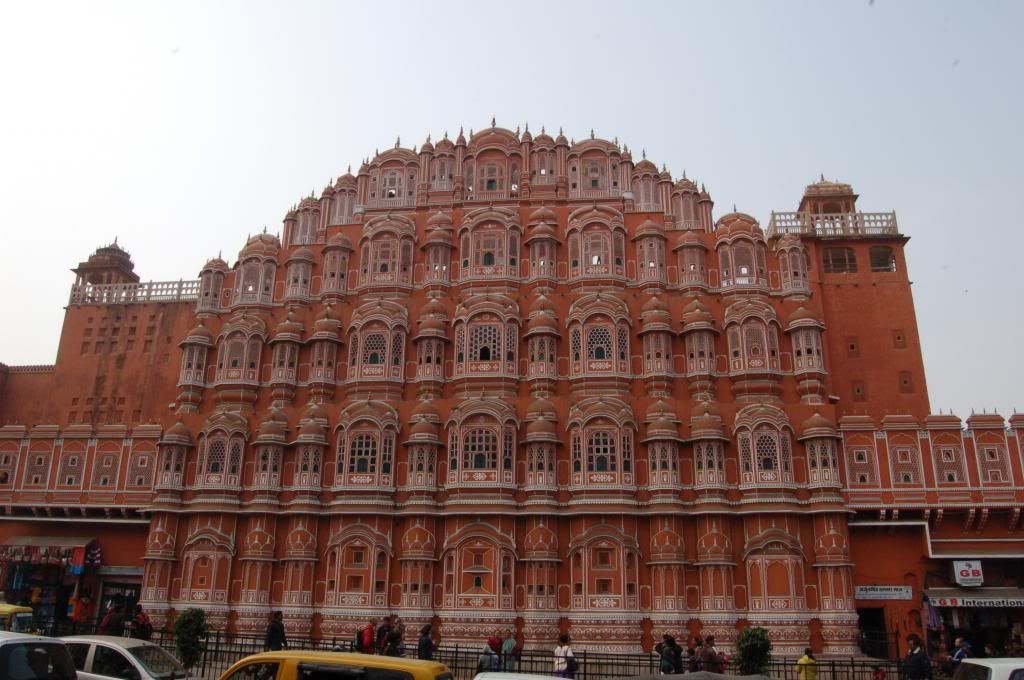 Built in 1799, Hawa Mahal is one of the most famous landmarks in the city of Jaipur. Its translation in English means the Temple of Wind. The reason it was given this name is all the tiny holes and windows in the structure, which can be seen above. These holes would let wind run through them and resonate, causing sounds to be made that were noticeably audible. Originally, the Hawa Mahal was built as a way for queens to view public processions. Because they were not allowed in public but still wanted to watch, the King built this giant temple with many windows that the Queens could look out from.
Built in 1799, Hawa Mahal is one of the most famous landmarks in the city of Jaipur. Its translation in English means the Temple of Wind. The reason it was given this name is all the tiny holes and windows in the structure, which can be seen above. These holes would let wind run through them and resonate, causing sounds to be made that were noticeably audible. Originally, the Hawa Mahal was built as a way for queens to view public processions. Because they were not allowed in public but still wanted to watch, the King built this giant temple with many windows that the Queens could look out from.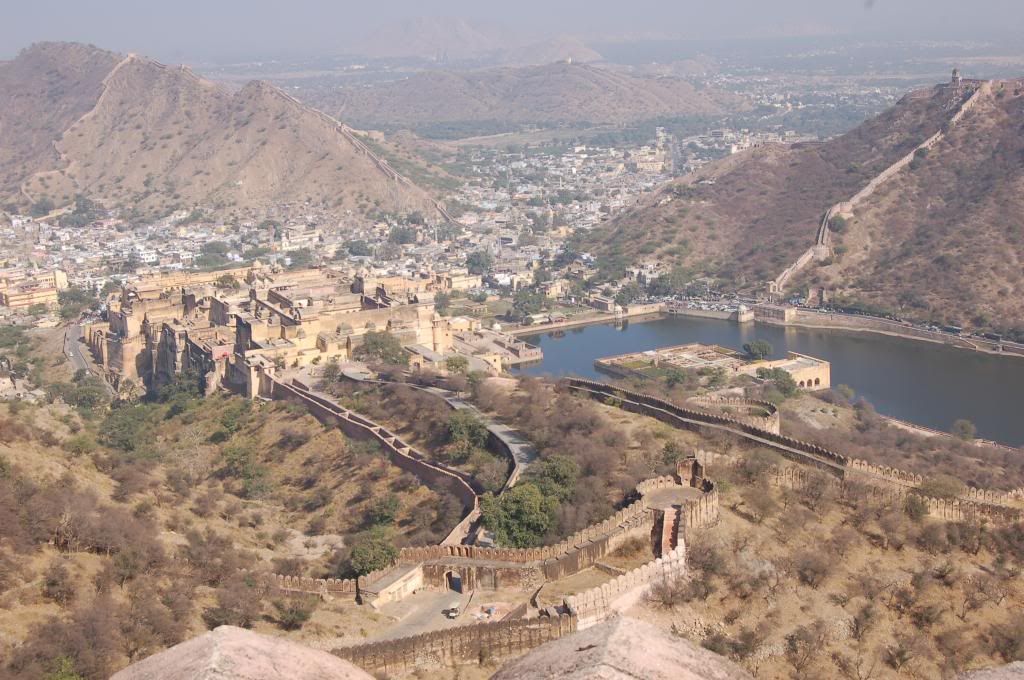 This view of the city of Jaipur is taken from a tall watchtower upon a mountain close to the city. The big structure towards the left of the picture is one of the most famous attractions in Jaipur, the Amber Fort. Built in 1592, the Amber Fort was the home of the rulers of Jaipur for over 300 years. Many members of the royal family, as well as the military took residence here, while overlooking the city.
This view of the city of Jaipur is taken from a tall watchtower upon a mountain close to the city. The big structure towards the left of the picture is one of the most famous attractions in Jaipur, the Amber Fort. Built in 1592, the Amber Fort was the home of the rulers of Jaipur for over 300 years. Many members of the royal family, as well as the military took residence here, while overlooking the city.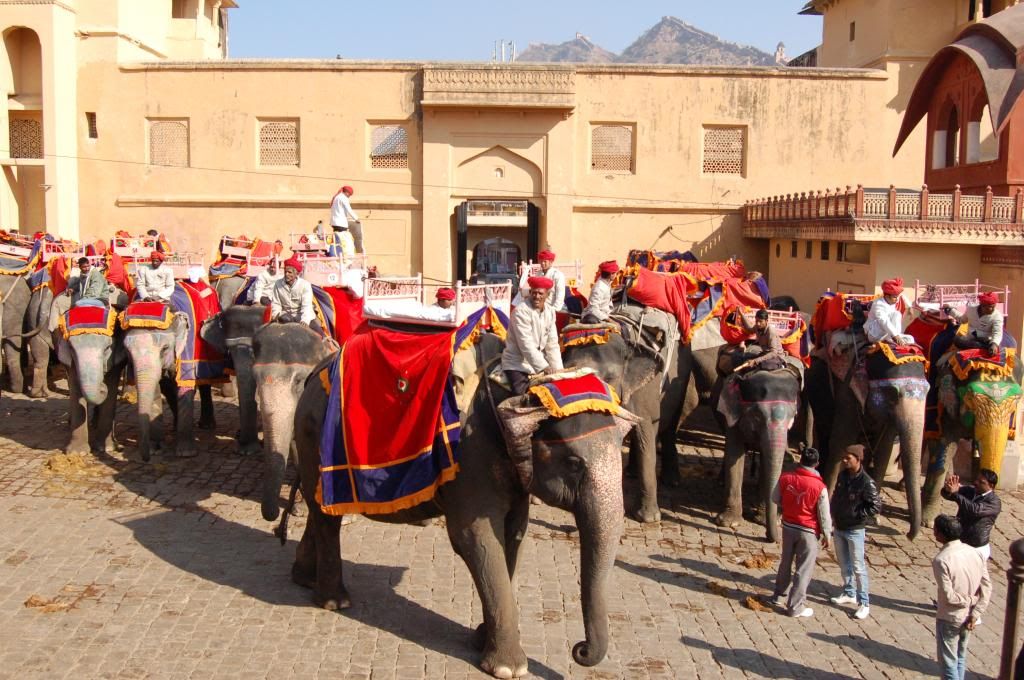 Of course, you can’t visit India without riding an elephant! For about $15, you and a friend can take a 30 minute ride up to the top of the Amber fort. This was definitely a highlight of my trip, and for many other tourists as well. In fact, the government keeps over a 100 elephants to make daily trips up and down to the fort, showing how popular this attraction really is. Everyone feels great to be standing tall and treated like royalty I suppose, even if only for half an hour!
Of course, you can’t visit India without riding an elephant! For about $15, you and a friend can take a 30 minute ride up to the top of the Amber fort. This was definitely a highlight of my trip, and for many other tourists as well. In fact, the government keeps over a 100 elephants to make daily trips up and down to the fort, showing how popular this attraction really is. Everyone feels great to be standing tall and treated like royalty I suppose, even if only for half an hour!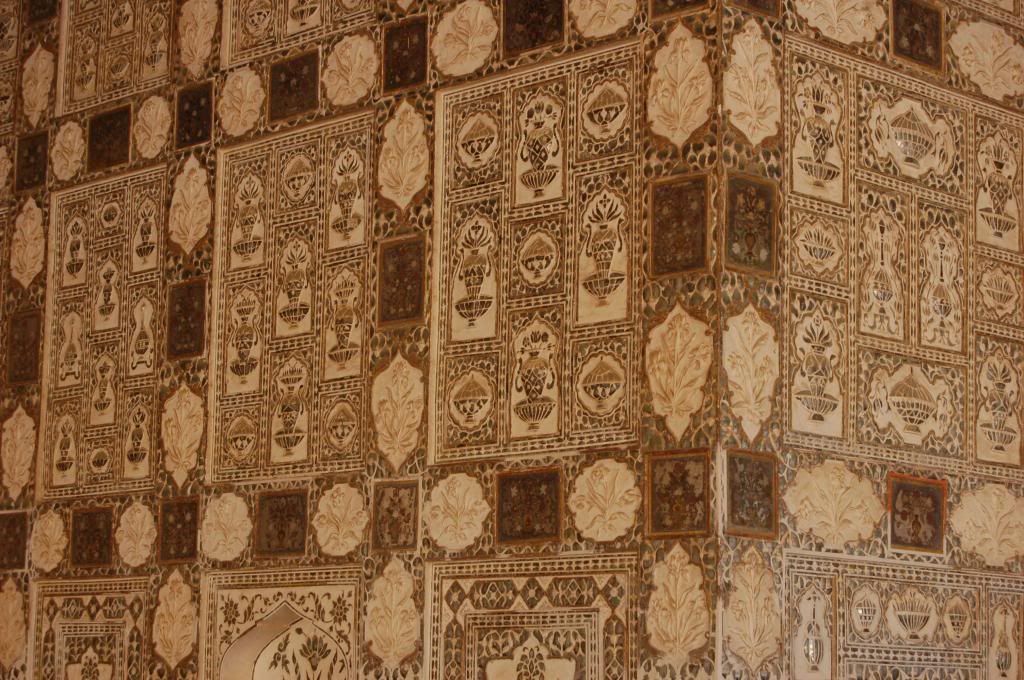 Perhaps one of the most interesting architectural pieces that I encountered on my trip is this room within the Amber Palace known as the Sheesh Mahal. Translated to the Mirror Palace, there is a famous legend behind the building of this room. Supposedly, one of the kings who lived in the Amber Palace, was very fond of one of his Queens. He told her that she could have anything she wanted, and she demanded a piece of the moon. Knowing that this was impossible, the king built this room, which has thousands of tiny mirrors to amplify the moonlight on a starry night to one place in the room, so as to ‘capture the moon(light)’.Just through exploring these two cities, I learned many things about my rich cultural and religious heritage. I encourage foreigners to visit these places in India, as well as other site around the country, especially if they are interested in the stories of kings and queens, Middle Eastern religions, and amazing architecture. I myself can’t wait to return to India sometime soon to explore other cities.All images by Param Bhatter, Prospect Staff Writer
Perhaps one of the most interesting architectural pieces that I encountered on my trip is this room within the Amber Palace known as the Sheesh Mahal. Translated to the Mirror Palace, there is a famous legend behind the building of this room. Supposedly, one of the kings who lived in the Amber Palace, was very fond of one of his Queens. He told her that she could have anything she wanted, and she demanded a piece of the moon. Knowing that this was impossible, the king built this room, which has thousands of tiny mirrors to amplify the moonlight on a starry night to one place in the room, so as to ‘capture the moon(light)’.Just through exploring these two cities, I learned many things about my rich cultural and religious heritage. I encourage foreigners to visit these places in India, as well as other site around the country, especially if they are interested in the stories of kings and queens, Middle Eastern religions, and amazing architecture. I myself can’t wait to return to India sometime soon to explore other cities.All images by Param Bhatter, Prospect Staff Writer
